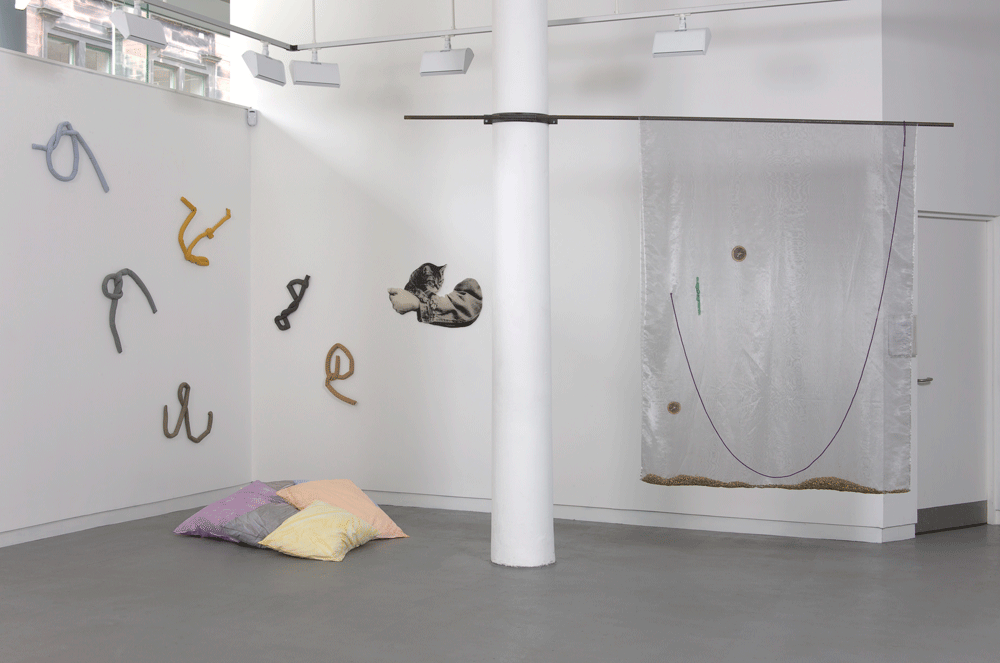Laura Aldridge
Transmission, Glasgow, UK
Transmission, Glasgow, UK

Why would a melon float in water when a lime sinks? In ‘Cats Are Not Important’, an exhibition of new works at Transmission, Laura Aldridge posed a number of simple sensorial propositions – for example, a low plinth that supported four large cylindrical glasses, two containing limes and others a single Galia melon (‘Holders’, all works 2010). The relative density of the fruit in relationship to the surrounding water was seen, if not rationally understood. Like Lygia Clark’s 1966 Air and Stone (an invitation to fill a polythene bag with warm breath, tie it with a rubber band and then try to balance a pebble upon its undulating surface), Aldridge’s work deals in the surprises presented by ordinary things.
The exhibition title refers to three monochrome screen prints on shaped Perspex, Hand Extended (i), (ii) and (iii), each of which depicts a pair of disembodied arms holding a domestic cat. This presentation of the act of stroking and cradling as a photographic fragment is intended to focus the viewer’s attention on the act of touching rather than the animal being touched. Aldridge’s emphasis on bodily sensation is underlined in another part of ‘Holders’: a group of grainy digital prints of different kinds of rocks and two photographs of caves, arranged around the containers of fruit. One view was taken from the interior of the cave looking out to the bright daylight, and the other from the vantage point of a group of tourists who are outside looking in to the dark interior. This inside/outside relationship recurred in the last photograph on the table, a cropped image of a girl with bad skin placing two fingers inside her mouth. Like the cat, the image of the cave/mouth is perhaps less important than the sensations it might evoke.
The grey-painted gallery floor was scattered with groups of pillows, titled Stones, tie-dyed in single hues of yellow, grey, pale blue, lilac or orange. The 1970s fashion designer Halston once said he loved tie-dye for its ‘limp, sensuous quality’ – a good description of these soft sculptures with their irregular crystal-like motifs. A metal band around one of the pillars in the gallery clamps a slender rail in place, around which a vast organza loop is hanging, with dried chamomile flowers and slices of dried fruit placed within its transparent layers (Double Interest). Aldridge has described the fabric, which can be pulled endlessly around the hanging bracket, as recalling an old-fashioned cloth ‘hand-towel dispenser’, of the kind now seldom seen but common to every railway station and restaurant during the 1970s. She is adroit at redeploying visual quotations from the decade that taste forgot: an earlier work, also entitled Holders (2008), consisted of a lumpen, glazed ceramic sculpture from which sprouted forth spider plants. The experience of nostalgia offered by her work, through the re-activation of techniques such as tie-dye and materials like potpourri and spider plants, becomes a kind of setting in which the spectator observes themselves physically remembering the colour, taste and texture of the past.
Attached to the walls was an untitled series of narrow tubes in woody greens and browns, pinks and ochres. These plaster-filled tubes were twisted and tied in knots, spelling out references to topological objects of study (such as Clark’s 1963 instructions on how to make a Möbius strip out of paper). Aldridge’s formulations – which also involve the stretching, looping, sewing and knotting of material props – allow us a way of witnessing how our bodily experiences change and are changed through time.
























